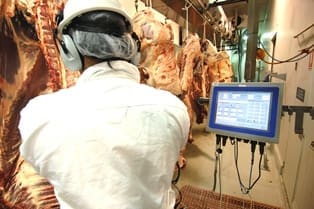PROCESSOR direct consignment grid offers came under considerable pressure last week, as further reports about export trade difficulty surrounding COVID-19 surfaced.
Some Queensland grids shifted up to 60c/kg during the course of last week, in advance of Beef Central’s Friday story about the difficult outlook for export beef.
 Best offers from processors in southern Queensland this morning were 580-590c/kg for four-tooth HGP-treated heavy grass steer, and heavy cows in a fairly wide band from 490-520c/kg. Grainfed offers for spot sales eased dramatically, falling from around 680c last week to 620-625c yesterday.
Best offers from processors in southern Queensland this morning were 580-590c/kg for four-tooth HGP-treated heavy grass steer, and heavy cows in a fairly wide band from 490-520c/kg. Grainfed offers for spot sales eased dramatically, falling from around 680c last week to 620-625c yesterday.
Similar grassfed money is available in plants in Central Queensland, with North Queensland 10-20c/kg behind that.
A large northern NSW export processor has offers this week for kills week commencing 13 April of 550c/kg for four-tooth HGP-free grass steer, and 500c/kg on heavy cows – down 50-60c/kg from offers made just a fortnight ago.
NSW over the hooks quotes for the week ended Friday on average eased 5c/kg last week, with heavy cows quoted at 527c and four-tooth heavy steer 581c. Victorian quotes were down 6c on average, to 508c on heavy cows and 585c on steers.
Despite the big pull-back that’s been observed in pricing, most northern processors appear to be in a considerably better position supply-wise this week than what they were two or three weeks ago. Most large plants are scheduling a full week’s kill this week, after a sequence of weeks where dark-days were enforced by meagre cattle supply.
That appears to be driven by three or four main factors:
- Producers now sense that the top of the market cycle has now been reached, and feel it’s best to offload stock before they move too far down the reverse side of the slope
- Some producers apparently hold concerns that beef processors might get caught-up in plant closures due to positive coronavirus detections, meaning they might not be able to get cattle killed at all for weeks, or even months
- Earlier wet weather issues that were hampering cattle movements have now been resolved, and western cattle, particularly, are able to flow east for processing again.
- Cash flow may be an issue, especially if some vendors are wary that slaughter operations may be put on hold due to disease issues.
“We’ve made it very clear that our plants will endeavour to continue to operate as normal during the coronavirus close-down period,” one large export processor said. “But all that changes if and when we get a positive test result in the workforce. Then it’s a whole different ballgame,” he said.
“We have a duty of care to our employees, but our intention, where possible, is to plough on.”
He said elaborate procedures and protocols had been in place for several weeks now, to try to protect abattoir staff at each site from infection.
While an exceptionally strong domestic retail market continues to provide an alternative for meat diverted out of some very flat export programs, domestic markets get zero benefit from the rapid slide in the Australian dollar that has been experienced over the past three weeks.
Some stakeholders suggest the closure of saleyards is a bigger prospect at this stage than the closure of abattoirs. Processors have made it clear to yards operators that they want to support the current protocols in purchasing slaughter cattle through the saleyards system, but have also left it up to individual buyers to leave, if they feel that safety standards are being compromised in any yards.
Most selling centres across Australia have now limited attendance at saleyards to ‘essential’ personnel only – essentially, active buyers, agents and yards staff.
At Gracemere, a large monitor has been erected in the selling ring, so vendors and other onlookers can watch the selling live, without compromising the personal distance restrictions. Other sales this week have been halted, briefly, to move people on who should not have been present in the vicinity of the selling process.
- There was no weekly eastern states kill data available from NLRS by the time this item was posted. It will be added later.

The Domestic market takes about 35 to 40% of our production we know that the domestic prices at retail have increased by at least 20% in a very short time frame and doomsday prepers increasing volume sales. A tanking AUS has made our beef cheaper on overseas markets and Chinas doors are reopening
Australian meat packers are making the most of the corona virus and dropping grids in unison. Bring on a Stockyard and Packers Act. Of course the Nationals don’t want it.
We’re preparing an update on domestic wholesale pricing trends in coming days. Not sure it will reflect what you’re suggesting, but let’s find out from those at the coalface in the trade. Editor